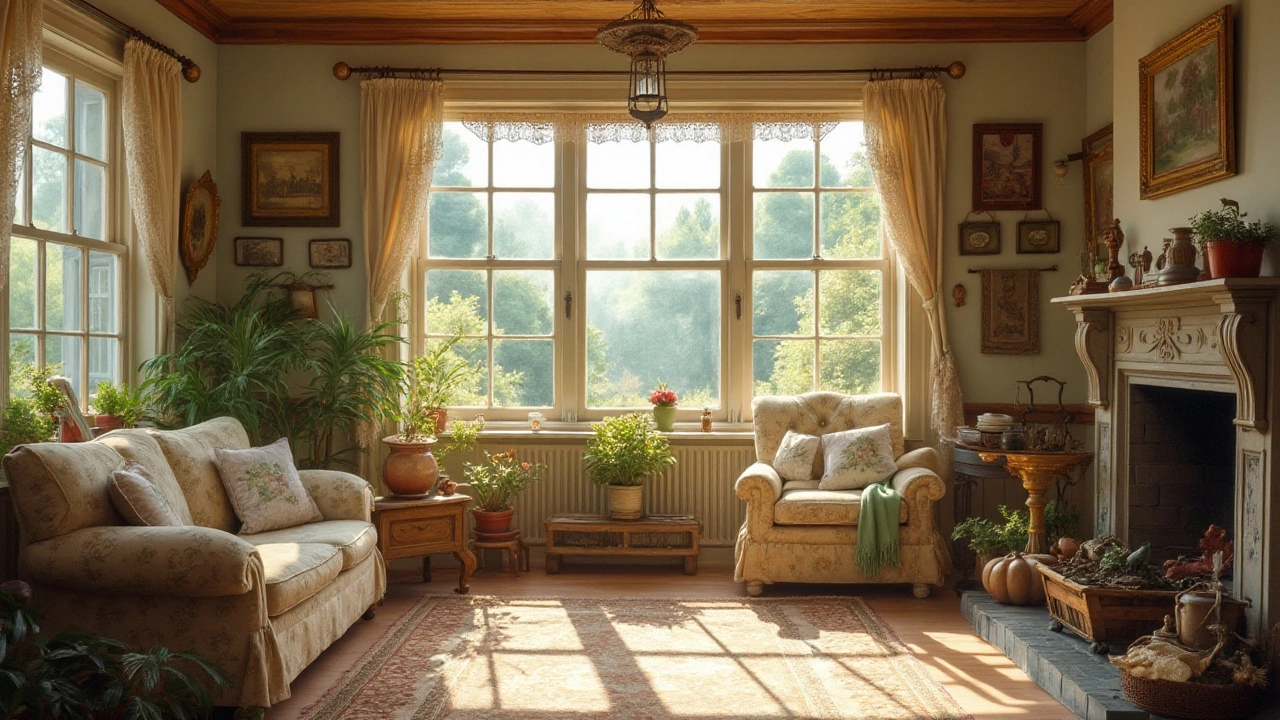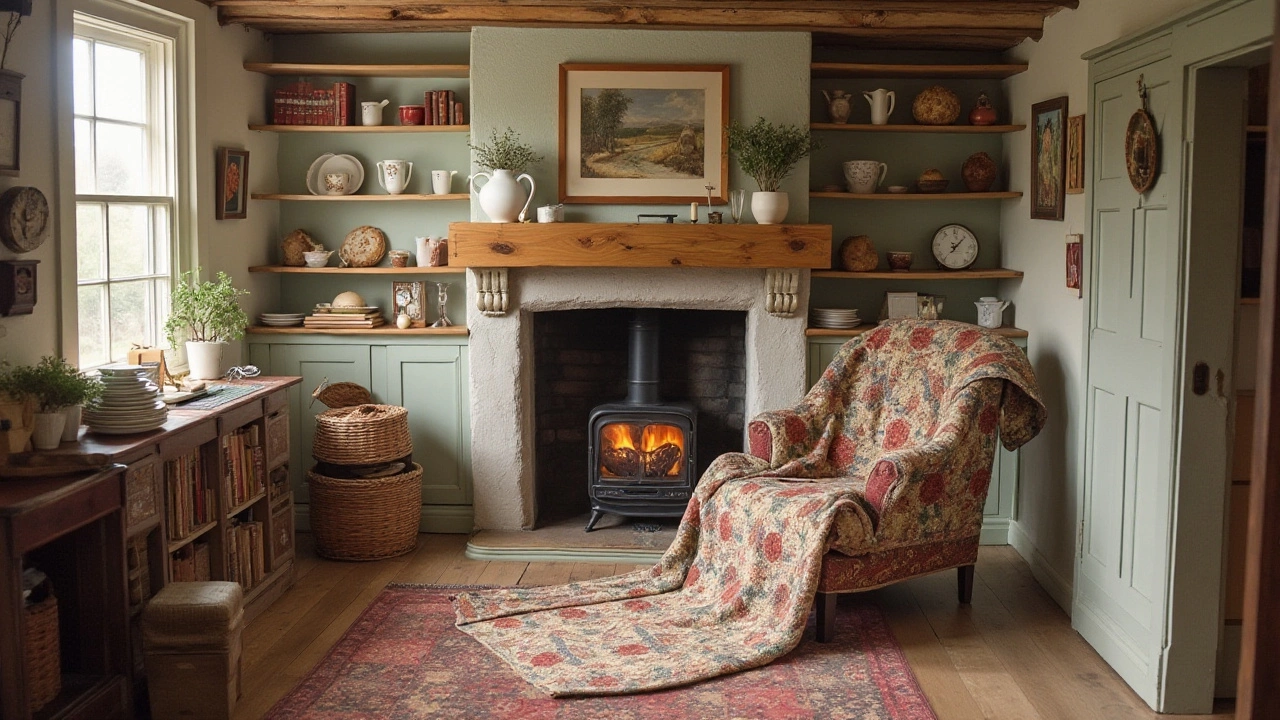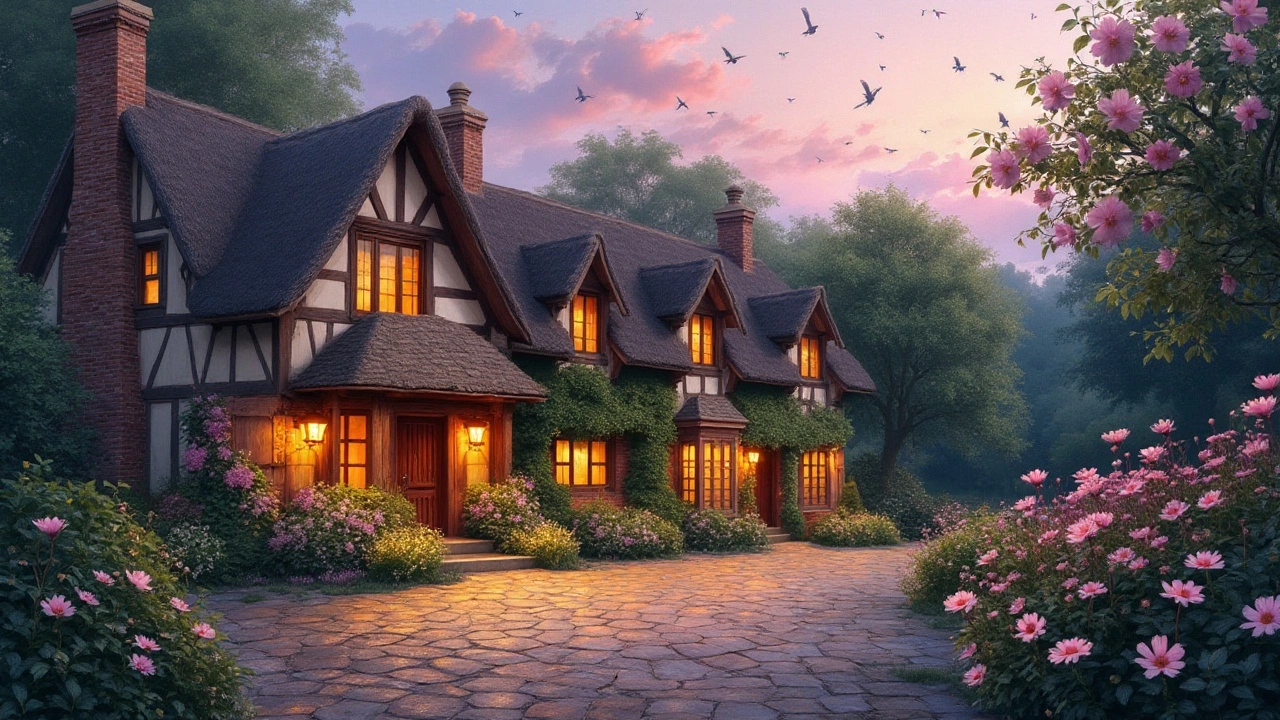The notion of mixing farmhouse and cottage styles might seem like a daunting task, yet it offers a delightful pathway to creating a home that's both charming and functional. These two styles, while distinct, share a common thread of warmth and simplicity that makes them ideal for blending.
Farmhouse style is renowned for its rustic charm and practical approach, while cottage design brings forth an air of whimsical elegance. Together, they form a timeless pair that celebrates personal expression and comfort. Whether you're aiming for a cozy retreat or a stylish abode, finding harmony between these two styles can elevate your living space.
This article will guide you through the process of intermingling elements of farmhouse and cottage decor, highlighting their shared characteristics and offering practical tips for crafting a space that mirrors your personality. Get ready to explore the fusion of textures, patterns, and historical elements that make this blend a charming choice for any home.
- Understanding Farmhouse Style
- Exploring Cottage Aesthetics
- Common Elements Shared
- Tips for Seamless Integration
- Creating Your Unique Blend
Understanding Farmhouse Style
The farmhouse style is a design trend rooted in rural and agricultural traditions, evoking a sense of nostalgia and simplicity that appeals to many homeowners today. This style draws inspiration from rustic homesteads, where each piece is as functional as it is beautiful. Farmhouses of the past were built to withstand the rigors of agricultural life, and this practicality remains at the heart of modern farmhouse decor. It's about mixing rugged, natural materials with understated elegance. Imagine wide-plank wooden floors, exposed beams, and earthy tones that create a comforting ambiance. The farmhouse aesthetic thrives on imperfect beauty; it's the small imperfections and the charm they bring that make the style unique.
At its core, this design embraces utility and simplicity. The color palette contains neutral shades of whites, beiges, and grays, accented by hints of black or natural wood tones. These colors form a serene backdrop, allowing accent pieces like a vintage wooden dining table or metal light fixtures to stand out. Open shelving is usually favored to display pottery, antiques, or handcrafted items, drawing attention to the personal touches that define the space. Textures play a significant role too, as rough-hewn woods and worn metals contrast beautifully with soft linens and cozy woolen textiles. The juxtaposition of materials speaks to the heart of farmhouse style, marrying old and new, rough and soft.
A hallmark of this style is its emphasis on spacious, open layouts designed for gathering and comfort. Often featuring large kitchen islands and inviting living spaces, the farmhouse home serves as a haven for hosting family and friends. Joanna Gaines, a prominent figure in popularizing this style, once remarked,
"The heart of a farmhouse is where people gather, and the lines between hospitality and home life blend together effortlessly,"encapsulating the essence of what makes this style enduringly attractive. It's not merely about aesthetics; it's about creating a space where life’s moments are shared and celebrated.
Throughout the years, the style has evolved, embracing more contemporary elements while remaining true to its origins. Modern interpretations may include sleeker lines, industrial lighting, or high-tech appliances discreetly incorporated into the design. Yet, the focus on creating a welcoming atmosphere persists. Shiplap walls, barn doors, and weathered finishes all tell a story, adding layers of character to the decor. There's no rush in assembling a farmhouse look—over time, curated antiques and cherished objects bring authenticity and depth to your home, making it uniquely yours.
To achieve this style, consider incorporating classic elements with a personal twist. Rustic wooden furniture can be enhanced with a coat of matte paint or distressed for an antique feel. Soft, neutral textiles for curtains, rugs, and pillows will add an extra layer of warmth, while metals like iron or aged bronze can offer a striking visual contrast. Whether you're decorating a sprawling countryside abode or a compact urban apartment, the adaptable nature of farmhouse design means it can be tailored to fit your space.
As a style that values comfort, tradition, and understated beauty, farmhouse design transcends trends, offering a timeless aesthetic. It invites you to create a sanctuary filled with treasures old and new, where every corner has a story, and every guest feels at home. Indeed, understanding the essence of farmhouse style reveals its enduring appeal and capacity to evolve with the times while remaining a stylish choice for those who cherish both history and hospitality.
Exploring Cottage Aesthetics
Diving into the world of cottage aesthetics is like stepping into a storybook of charm and nostalgia. This style is known for its cozy and intimate vibe, often channeling the essence of quaint countryside retreats. Cottage interiors are characterized by soft, muted color palettes that evoke a sense of tranquility and peace. Think shades of pastels or faded hues that remind one of a serene morning in a secluded village.
A critical feature of a cottage-inspired space is its emphasis on comfort and warmth. Furnishings are typically overstuffed, with an inviting appeal that begs you to sink in with a good book. Overstuffed sofas, plush armchairs, and fluffy throws create a haven of relaxation. Textiles play a vital role, and patterns like gingham, floral prints, or timeless stripes are generously used to enhance the quaint charm.
Material Matters
Materials in cottage designs often lean towards the natural and worn-in look. You'll find plenty of embraces of weathered woods, brushed metals, and handcrafted items that tell a tale of history and use. It's about celebrating imperfections, like a well-loved wooden table that holds memories of afternoon teas or breakfasts with family. Skip the sleek and polished; instead, opt for pieces that whisper tales of a simpler time.
"The cottage style is less about meticulous design and more about curating a sanctuary that feels inherently personal," says interior designer Sarah Richardson.
Decorations within cottage homes are kept personal and meaningful. Walls may be adorned with an eclectic mix of art, often leaning towards the handmade or collected focus. Vintage finds are staples here, whether it's a framed cross-stitch piece or a traditional landscape painting. There's an element of storytelling, where every decorative item seems to have a background or family connection.
Key Elements of Cottage Style
A quintessential aspect of cottage aesthetics is the celebration of imperfection. This is where patina takes the spotlight. Age-worn finishes, slightly chipped ceramics, or faded curtain fabrics all contribute to a lived-in, welcoming atmosphere. It's essential to strike a balance, ensuring that these elements convey coziness rather than clutter. One can arrange collected items in a manner that feels curated yet natural, layering textures for added depth and interest.
The addition of nature-inspired decor is prevalent. Whether through a vase of fresh wildflowers or a delightful houseplant, bringing the outdoors in often accentuates the connection between the home and its natural surroundings. Seasonal changes are mirrored in the decor, and there's always a touch of the organic to bring life into the space.
Creating a cottage vibe isn't about replicating a specific look but rather infusing spaces with an aura of warmth and invitation. Blend nostalgic touches with modern sensibilities, and you'll have a home that feels as welcoming as an embrace, a perfect start before considering mixing with the farmhouse style elements.

Common Elements Shared
When blending farmhouse style and cottage decor, the shared elements between these two design philosophies often become the touchstones for creating that perfect cozy and inviting home. Both styles are deeply rooted in tradition and simplicity, focusing on the use of natural materials and an inviting ambiance. Wood is a fundamental element in both styles, whether it's rough-hewn beams in a farmhouse or weathered wood in a cottage. This ubiquitous use of wood not only provides structural integrity but also a warm, textured atmosphere that invites relaxation. From reclaimed barn wood in furniture to shiplap walls, the natural, tactile quality of wood is a perfect fit for both styles.
Another commonality lies in the use of fabrics. Both styles favor natural fibers like cotton and linen. Farmhouse flair often incorporates simple, no-fuss utility fabrics, while cottage charm might lean towards more feminine prints like florals or gingham. However, there's also crossover here, like using ticking stripes or vintage-inspired quilts that highlight both styles' love for comfort coupled with practicality. Layered textiles on plush furniture can add warmth and depth, creating spaces that are as inviting as they are practical.
The color palette is a crucial component of both the cottage and farmhouse looks. You’ll often find a penchant for soft whites, muted pastels, and warm neutrals in each. In a farmhouse setting, you may see bolder choices such as barn reds or mustard yellows, often echoed in rustic painted cabinetry or accent pieces. Meanwhile, cottage design embraces delicate blues or soft greens that mimic the seaside or garden surroundings but are softened and faded for a timeworn look. Despite these differences, both styles favor aged finishes that replicate the passage of time and lend authenticity to their charm.
Let’s not overlook the love for vintage and antique elements. Whether it’s an old iron bedframe, a well-forged chandelier, or vintage farmhouse signs, each style cherishes items with character and history. A vintage chest can serve as a coffee table in a cottage, while a farmhouse might feature an antique hutch displaying stoneware. These treasured pieces bind the two styles together with a shared appreciation for history and craftsmanship, making each decor choice more personal and meaningful.
According to interior designer Joanna Gaines, "A beautifully styled home is one where the old meets new in a cohesive way. When you blend these elements thoughtfully, you create a space that feels unique yet thoroughly lived-in."
Additionally, both styles cherish their connection to nature, often expressed through indoor plants. Farmhouse homes might lean towards simple potted herbs or rustic planters, while cottage decor could favor climbing ivy or delicate floral bouquets, but both use greenery to invite the outdoors in, adding a sense of continuity and eco-friendly serenity. The tactile connection of living plants with the tactile textures of wood, fabric, and even iron creates a well-rounded environment that’s as refreshing as it is comforting.
Tips for Seamless Integration
Blending farmhouse style with cottage decor requires a nuanced approach. Begin by selecting a color palette that both anchors and unifies the two styles. Earthy tones, soft pastels, and muted shades are popular in both styles, offering an excellent starting point. This harmony allows for a seamless look that doesn't jar the senses, while still giving each element its own voice. Employing variations within these color schemes, such as deep greens with lighter shades or rich browns with delicate creams, can further enhance the blend.
Creating balance is key when integrating different styles. To achieve this, focus on the principles of scale and proportion. Farmhouse elements, like oversized wooden tables or large barn-style lighting fixtures, command a room's attention, while cottage items often feel more delicate. Mixing these elements strategically can prevent either style from dominating. Use larger farmhouse pieces as focal points and weave in cottage decor through textiles, like cozy cushions and soft throws, to introduce hints of texture without overwhelming the space.
Patterns play a significant role in differentiating styles. In farmhouse design, you would often find plaids or stripes, while cottage interiors revel in florals and ginghams. To integrate these seamlessly, consider layering one prominent pattern with smaller, complementary prints. This juxtaposition not only enhances visual interest but also ties the individual elements together. Balance is necessary, so if you have a bold patterned sofa, offset it with solid-color cushions or a simple area rug.
"Creating a welcoming space is all about personality," suggests interior designer Jane Pritchard. "Don't be afraid to mix your favorite styles—just ensure they speak the same language through color, texture, and scale."
Functionality and comfort are central to both styles, which makes combining them a practical choice. Introduce plush seating arrangements to evoke the homey feel of a cottage, while incorporating farmhouse elements such as exposed beams or shiplap to instill a sense of authenticity. Look for antique or vintage pieces that align with both aesthetics—an old farm door repurposed as a dining table can marry the rustic with the refined, serving as a beautiful testament to blending eras and styles.
Don't forget the importance of personal touches. Whether it's hand-crafted art from local artisans, family heirlooms, or items that hold sentimental value, these elements are what truly bring life to a living space. An antique quilt draped over a modern couch or a collection of vintage glass bottles on a rustic shelf can serve as conversation starters and make your home distinctly yours. After all, the best homes speak to the personalities of their inhabitants, making every visit a warm and welcoming experience.
When it comes to lighting, use it to enhance the mood and aesthetic of the room. Combine the utilitarian fixtures of farmhouse style with the softer, ambient lights often found in cottage decor. Consider pendant lights with an antiqued finish for that rustic charm or delicate chandeliers for a touch of whimsy. Strategically placing lamps to accentuate key features of your decor can be both functional and aesthetically pleasing, ensuring that your home is as cozy by night as it is charming by day.
| Element | Farmhouse | Cottage |
|---|---|---|
| Color Scheme | Earthy, Muted | Pastels, Light |
| Texture | Natural, Raw | Soft, Delicate |
| Pattern | Plaids, Stripes | Florals, Gingham |

Creating Your Unique Blend
Crafting a distinctive space by merging farmhouse style and cottage decor is an exciting venture, offering homeowners a canvas to express their creativity and personal taste. This blend invites the soft, rustic elements of farmhouse style to mingle with the quaint, inviting details of cottage design, forming a home that is both reflective of its inhabitants and exceedingly welcoming to guests. To embark upon this stylistic journey, it’s essential to appreciate the core elements of each style and how they can be artfully intertwined.
Farmhouse style predominantly revolves around practicality melded with historical charm. It often utilizes raw, natural materials like wood and stone, accompanied by a neutral color palette to foster a serene environment. Exposed beams, natural wooden furniture, and soothing earth tones are staples in this style, while metal fixtures often provide an industrial twist. Cottage decor, on the other hand, is synonymous with warmth and coziness, characterized by floral patterns, pastel hues, and soft, plush furnishings. The predominant aim here is to create an inviting and comfortable atmosphere, reminiscent of idyllic, storybook homes. By merging these elements, you can create a vibrant home full of nostalgia and innovation.
Begin your unique blend by identifying key pieces from either style that resonate with your personal taste. Perhaps it is a vintage weather-worn dining table that speaks to the rustic allure of the farmhouse, or a comfy pastel-colored armchair that aligns with the cozy aesthetic of the cottage. When selecting furniture and decor, opt for a balance—pair a farmhouse table with cottage chairs, blending different finishes and textures to add depth and interest to the space. Additionally, considering lighting can dramatically influence the ambiance; warm, glowing lights can soften the expansiveness of farmhouse spaces, complementing the comforting vibes of cottage decor.
"The magic is in the mix: juxtaposing bold and delicate elements to create a space that feels both contemporary and timeless," says Emily Henderson, a celebrated interior designer known for her eclectic approaches to home styling.
The Role of Colors and Patterns
When combining these two styles, color and pattern play pivotal roles. Farmhouse style thrives on neutral shades—think whites, creams, and greys—that serve as the perfect canvas for the brighter, more vibrant splashes often found in cottage decor. Integrate floral prints or lace patterns as accents through cushions, wallpaper, or curtains. Layering textures is equally crucial; think an elegantly woven rug or a delicately crocheted throw, both of which can bridge the elements of both styles, creating a cohesive and inviting atmosphere.
Incorporating Accessories
Accessories in your home can reflect personal stories or travel experiences, adding layers to your design narrative. Vintage items, such as a worn leather-bound book, a hand-carved mantelpiece, or antique ceramics, can provide the farmhouse touch, while cottage style shines through with quaint collectibles like porcelain teapots or embroidered quilts. Letting each piece speak for itself while harmonizing within the environment encourages interaction and participation from your guests. Incorporating greenery, such as indoor plants or even a small herb garden, can also blend the two styles beautifully, bringing life and freshness into your space.
Merging farmhouse and cottage styles does not mean adhering to strict rules; rather, it's about experimenting, mixing, and playing with the perfect balance that suits your vision for comfort and aesthetic appeal. This combination not only cultivates an environment ripe with character and warmth but also presents a home that tells a unique tale—a true reflection of those who reside within. The possibilities are limitless, and the charm eternal, making this blend a cherished choice for those who seek beauty and comfort in harmony.
